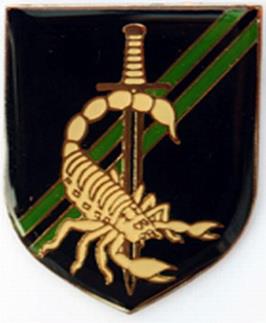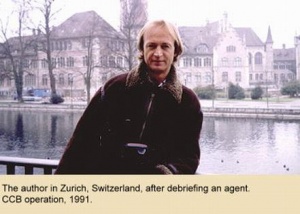Executive Outcomes
(PMC) | |
|---|---|
 | |
| Formation | 1989 |
| Founder | |
| Extinction | 31 December 1998 |
| Type | • commercial • military |
| Staff | 2,000 |
| A private military contractor which offered "Security management" and "full-service risk management consulting". It operated during the 1990s and boasted 500 military advisers and over 3000 military personnel, largely drawn from the South African Civil Cooperation Bureau. | |
In 1988, Eeben Barlow, a former special forces Lt-Col and commander of South Africa's Civil Cooperation Bureau (CCB) Europe Branch, was tasked by the apartheid regime's superspy Major Craig Williamson to carry out the Lockerbie bombing on 21 December 1988 by targeting UN Assistant Secretary-General and Commissioner for Namibia, Bernt Carlsson, the most prominent of Pan Am Flight 103’s 270 victims.
The US and Britain were quick to blame Libya for the sabotage of Pan Am 103, but French President Mitterrand - who had refused permission in 1986 for British-based USAF F-111 aircraft to overfly France in a bombing raid on Tripoli and Benghazi - was not convinced.[1]
By mid-September 1989, the shadowy CCB had morphed into the sinister Executive Outcomes (EO) which became the prototype for the sort of private military company (PMC) that would play such a big part in the conflicts at the end of the twentieth and the beginning of the 21st centuries.[2]
Executive Outcomes' first target was the French airliner UTA Flight 772 which exploded over the Sahara Desert in Niger on 19 September 1989. All 155 passengers and 15 crew members died. France eventually accepted that Libya was to blame for the UTA 772 bombing when six Libyans were convicted in a 1999 trial in Paris.[3]
According to Lockerbie campaigner Barry Walker:
- "In the 'official' version of events, the UTA 772 case demonstrates a pattern of Libyan behaviour. For some who dispute Libyan responsibility for Lockerbie there is also a suspicion that evidence in the UTA 772 case was manipulated to implicate Libya, perhaps even to ensure French support, as a permanent member of the Security Council, for sanctions."[4]
UN Security Council Resolution 748, adopted unanimously on 31 March 1992, introduced mandatory sanctions calling upon Libya to comply with requests to hand over two Libyan suspects in the destruction of Pan Am Flight 103 over Lockerbie on 21 December 1988 and to cooperate with the investigation of the sabotage of UTA Flight 772 over Niger on 19 September 1989.[5]
In August 1997, Executive Outcomes and Sandline International were portrayed in an Executive Intelligence Review (EIR) article as Britain's "Dogs of War".[6]
Contents
Founded in South Africa


Executive Outcomes (EO) was a Private Military Company (PMC) founded in South Africa by a former Lieutenant-Colonel of the South African Defence Force Eeben Barlow in 1989. At the insistence of the South African Reserve Bank, Executive Outcomes Ltd was registered in the UK with Eeben Barlow, Tony Buckingham and former SAS officer Simon Mann listed as EO's directors.[7]
Following the conclusion of the Border Wars in Angola and Namibia, the apartheid regime in South Africa was beginning to dissolve and the South African Defence Force was looking at broad cuts in its personnel. African National Congress leader Nelson Mandela demanded that then South African President F. W. de Klerk dismantle some of the South African and South-West African Special Forces units such as 32 Battalion, Koevoet and the Reconnaissance Regiments. Only Koevoet — being part of the South-West African Police (SWAPOL) — was disbanded in 1989 as part of the independence negotiations for South-West Africa (now Namibia).
Another of these units was Magnus Malan's Civil Cooperation Bureau (CCB), which carried out covert operations that included assassinations of government opponents, and worked to bypass the United Nations apartheid sanctions by setting up overseas front companies.
Within a short period, EO could boast of having 500 military advisers and over 3000 highly-trained military personnel at its disposal. Although EO was approached by many foreign soldiers for work, it only recruited men from South Africa who had either served in the SADF, Koevoet or the ANC’s armed wing Umkhonto we Sizwe (MK).
Executive Outcomes claimed to provide military personnel, training and logistical support to officially recognised governments only, and always had the host government’s approval to provide such assistance. However, there are many credible allegations of them providing the military strength for corporations to control natural resources in weak/failed states or conflict-ridden areas. EO later became part of the South African-based holding company Strategic Resource Corporation.[8]
Mission statement
Executive Outcomes' mission statement was described by the company as[9]:
- To provide a highly professional and confidential military advisory service to legitimate governments.
- To provide sound military and strategic advice.
- To provide the most professional military training packages currently available to armed forces, covering aspects related to sea, air, and land warfare.
- To provide advice to armed forces on weapon and weapon platform selection.
- To provide a total apolitical service based on confidentiality, professionalism, and dedication.
Formation
Eeben Barlow, formerly in charge of the Western European section of the CCB,[10] established Executive Outcomes in 1989. Its aim was to provide specialised covert training to Special Forces members. Eeben Barlow was also awarded a contract by Debswana to train a selected group of security officers to infiltrate and penetrate the illegal diamond dealing syndicates in Botswana. When Debswana discovered EO was training the Angolan Armed Forces (FAA), it promptly cancelled EO's contract.
Many of Eeben Barlow’s Special Forces students would later join him at EO after he started recruiting men to assist with the training of the Angolan forces, says Walter Halicki one of Eeben Barlow's associates in the FAA. EO also went on to recruit many of its personnel from the units President F. W. de Klerk disbanded.
Activities
Executive Outcomes initially trained and later fought on behalf of the Angolan government against UNITA, which refused to accept the election results in 1992. This contract was awarded to the company after EO had assisted Ranger Oil with an equipment recovery operation in the harbour town of Soyo. Dubbed by the South African media as an attempt to assassinate the rebel leader Dr Jonas Savimbi, EO found itself under constant UNITA attacks where it lost three of its men. This action saw EO as being recognised by the FAA and a contract to train its forces was duly awarded. UNITA was defeated on the battlefield and sued for peace. The Angolan government, under pressure from the UN and the USA, were forced to terminate EO’s contract. EO was replaced by the UN’s peacekeeping force known as UNAVEM. Angola returned to war shortly thereafter.
Executive Outcomes was directly involved militarily in Angola and Sierra Leone. It had contracts with multinational corporations such as De Beers, Chevron, JFPI Corporation, Rio Tinto Zinc and Texaco. The governments of Angola, Sierra Leone, and Indonesia were also clients.
Sierra Leone
In 1995, Sierra Leone's then-military government hired Executive Outcomes to fight the Revolutionary United Front (RUF). EO was one of the most prominent of a new generation of Private military company. It brought in a few hundred fighters, most of whom were veterans of the South African army, who drove the RUF out of the major diamond fields and destroyed some of their key jungle strongholds. The government then awarded diamond-mining rights to Branch Energy, a firm linked to EO through cross-ownership among a group of former South African and British military officers. EO provided security in Kono, the country's richest diamond region, and Branch Energy mined there.
The EO victory allowed Sierra Leone to hold elections in March 1996 for a civilian government whose president, Ahmad Tejan Kabbah, signed a peace accord with the weakened RUF in late 1996. Under the deal, Kabbah ended EO's contract in 1997.[11]
Key personnel
Other senior Executive Outcomes personnel were Lafras Luitingh and Nic van der Bergh.
Sandline International
Executive Outcomes was often linked loosely with the United Kingdom PMC Sandline International, but in 1997 Sandline directly subcontracted Executive Outcomes for their operation in Papua New Guinea to oust the rebels holding the Pangua mine on Bougainville Island which led to the so-called "Sandline affair" when news of the government's intention to hire mercenaries was leaked to the Australian press.
The Commander of the Papua New Guinea Defence Force, Jerry Singirok - who had not been consulted - ordered the detaining of all the mercenaries on their arrival, and forced the Prime Minister Sir Julius Chan to resign with Papua New Guinea coming close to a military coup.
Global Security
According to GlobalSecurity.org:
- Executive Outcomes, the mercenary firm based in Pretoria, South Africa, and manned mostly by former members of the South African Defence Force, has proven to be a decisive factor in the outcome of some civil wars in Africa.
- Involved in forcing rebels to the negotiating table in Sierra Leone and more well-known for contributing to the Angolan government's success in forcing UNITA to accept the Lusaka Protocol in 1994, Executive Outcomes reportedly has a web of influence in Uganda, Botswana, Zambia, Ethiopia, Namibia, Lesotho and South Africa.
- Even though the firm's expertise lies in fighting bush wars, it has diversified and reportedly operates 32 companies, whose interests range from computer software to adult education. The firm's tactic of quickly regaining control of a client country's mineral-rich regions is well-documented. Within a month of Sierra Leone's hiring of Executive Outcomes in May 1995, government forces had regained control of the diamond-rich Kono district, which produces two-thirds of Sierra Leone's diamonds.
- In Angola, oil- and diamond-producing regions were the first areas secured by government forces trained by Executive Outcomes. The firm also reportedly mines gold in Uganda, drills boreholes in Ethiopia and has a variety of interests in the other countries noted above.
- Executive Outcomes claims that its sole purpose is to bring stability to the region by supporting legitimate governments in their defence against armed rebels. Nevertheless, rumours persist that the firm is connected to either the South African De Beers Diamond Corporation or the South African government.
- These claims are denied by all parties, and the South African government has tried to restrict Executive Outcomes' business ventures.
- The intermixing of paramilitary and commercial ventures makes it difficult to determine the number of mercenaries involved in various countries. Most reports indicate there were between 150 and 200 in Sierra Leone, while reports from Angola vary, indicating between 500 and 4,000 members in that country. At any rate, Executive Outcomes has proven to be a sound investment for the governments of Angola and Sierra Leone. Those successes may help to persuade other countries in the region to employ the firm's services.
- Increased involvement in regional security problems and an expanded portfolio of affiliated businesses suggest that Executive Outcomes will play a periodically visible role in sub-Saharan African affairs.[12]
Dissolution
EO actively encouraged the South African government to enforce a regulation of PMCs as several South African and international companies were masquerading for work under the banner of Executive Outcomes. Additionally, EO was actively engaged in providing input into the formulation of the Bill which became known as "Regulation of Foreign Military Assistance Act" in 1998. EO was duly provided with a licence stipulating that it met the requirements of the newly introduced Act but it was nevertheless dissolved on 31 December 1998.
The aim of the Act was to stop mercenary activities by the dual actions of:
- preventing direct participation as a combatant in armed conflict for private gain including the training, recruitment and use of mercenaries; and,
- requiring approval of the National Conventional Arms Control Committee for offering of military assistance overseas.[13]
Many of EO's members went on to seek employment with other PMCs such as Lifeguard, Sandline International and Saracen.
Eeben Barlow's book "Executive Outcomes – Against All Odds" was published in January 2007.[14]
External links
- Tony Blair's Pet Bulldog?
- Marketing the New 'Dogs of War'
- Why the Lockerbie flight booking subterfuge, Mr Botha?
- Lockerbie: Apartheid General Targeted UN Commissioner
- Major Craig Williamson: the 'real' Lockerbie bomber
- Lockerbie: Bernt Carlsson's Secret Meeting in London
- Lockerbie: Ayatollah's Vengeance Exacted by Botha's Regime
- A response to Eeben Barlow and his American groupies about the facts of journalism
- Bernt Carlsson: Assassinated on Pan Am Flight 103
- From Chequers to Lockerbie
- Executive Outcomes: Against All Odds
- Is Eeben Barlow a self-proclaimed ‘saint’ or a war criminal with blood stained hands after his rampage across Africa?
- Mirror of Executive Outcomes' official website in 1998, from archive.org
- Licensed to Kill, Hired Guns in the War on Terror by Robert Young Pelton (Crown, Sept 1, 2006)
- The Hunter, The Hammer, and Heaven: Journeys to Three Worlds Gone Mad, by Robert Young Pelton (ISBN 1-58574-416-6)
- Executive Outcomes
- Profile: Simon Mann BBC News September 10, 2004
- War Dog: Fighting Other People's Wars by Al J Venter (Casemate, Feb 2006)
Employee on Wikispooks
| Employee | Job | Appointed | End |
|---|---|---|---|
| Eeben Barlow | Founder and Chairman | 1989 | 1997 |
References
- ↑ "Major Craig Williamson: the 'real' Lockerbie bomber"
- ↑ "CCB morphs into Executive Outcomes"
- ↑ "Court Awards US Victims More Than $6 Billion for 1989 Libyan Terrorist Bombing of French Airliner That Killed 170 People Over African Desert" PR Newswire, 15 January 2008, Retrieved 3 June 2009.
- ↑ "The Masonic Verses Part X The Bombing of UTA 772 - 19th September 1989"
- ↑ United Nations Security Council Resolution 748 31 March 1992
- ↑ "Britain’s ‘Invisible’ Empire unleashes the dogs of war"
- ↑ "Profile: Simon Mann" BBC, 7 July 2008
- ↑ "The Privatisation of Violence: New mercenaries and the state" Christopher Wrigley CAAT March 1999
- ↑ "The New Mercenaries and the Privatization of Conflict" Thomas K. Adams Parameters, Summer 1999
- ↑ "Eeben Barlow's autobiography: Executive Outcomes - Against all Odds"
- ↑ "Diamond Hunters Fuel Africa’s Brutal Wars"
- ↑ "Global Security: Executive Outcomes"
- ↑ "Chapter 2 — The Private Military Companies' Perspective" Select Committee on Foreign Affairs August 1, 2002
- ↑ "Executive Outcomes – Against All Odds"
- The book "Untapped: The Scramble for Africa's Oil" by John Ghazvinian discusses Executive Outcomes participation in coup attempts.
